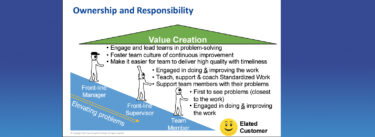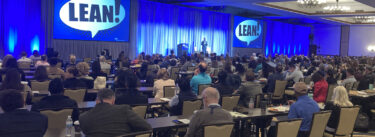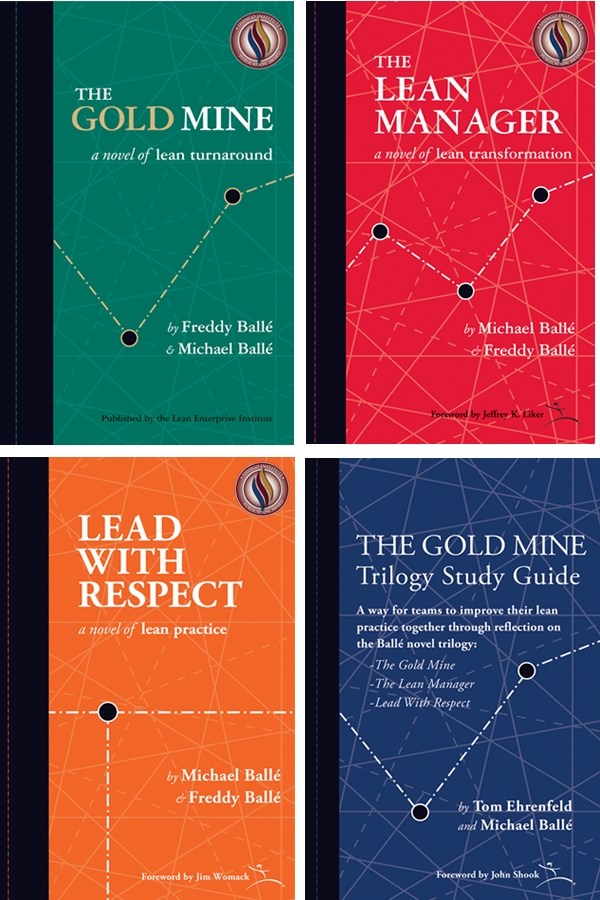I’ve been reflecting on today’s remarkable headlines about the latest retreat by the Ford Motor Company as part of its “Way Forward” campaign. While reflecting, I have found it useful to think about the history of lean thinking at Ford, going back nearly 100 years. I believe it offers many useful lessons for our current-day lean journey and Ford’s immediate choices.
The historical record is clear. Henry Ford was the world’s first systematic lean thinker. His mind naturally focused on the value creation process rather than assets or organizations. And he was the first to see in his mind’s eye the flow of value from start to finish, from concept to launch and from raw material to customer. In addition, Ford was history’s most ferocious enemy of waste. (Except, possibly, Taiichi Ohno at Toyota who claimed that he learned what to do from reading Henry Ford’s books.)
Ford relentlessly emphasized the need to analyze every step in every process to see if it created value before finding a way to do it better. Otherwise the step should be eliminated. (This was Ford’s greatest criticism of Fredrick Taylor and Scientific Management. Why, asked Ford, was Taylor obsessed with getting people to work harder and more efficiently to do things that actually didn’t need to be done if the work was organized in the right sequence and location?) Then, when the wasteful steps had been eliminated, it was time to put the rest in continuous flow.
By 1914 at his Highland Park plant Ford had located most of the manufacturing steps for his product – the Model T – in one building and had created very nearly continuous flow in many parts of the operation, using single-piece-flow fabrication cells for components in addition to the moving final assembly line. He had even devised a very primitive pull system by using “shortage chasers” on timed routes along the assembly line to check inventories at every assembly point and convey the information back to the fabrication areas. This speeded up upstream processes that had fallen behind and slowed down those that were getting ahead.
Equally remarkable, Ford had designed his Model T in only three months in one large room with a small group of engineers under his direct oversight. This surely was a high point in lean practice for decades to come.
Then it gradually fell apart. Ford’s span of management control at Highland Park had been remarkably broad because he could easily take a walk to see the condition of every process, in design, assembly, and fabrication. And he could train a cohort of managers to see what he was seeing and remove more waste. No abstract measures of performance were needed.
However, as the company grew Ford’s personal management method became impractical. But what to replace it with? Ford himself seems not to have had an answer except to link every step by conveyors – as he attempted to do at the massive Rouge complex completed in the late 1920s. By the 1930s the whole Ford Motor Company was in a sense one linked process. (Ohno, of course, realized that lengthy conveyors governed by a central schedule are a push not a pull system, but this was much later.) Did this mean that in the founder’s mind that the company needed only one manager — Ford himself — even as it became the world’s largest industrial enterprise?
In any case, the system came crashing down in the 1930s as Ford tried to produce multiple products with multiple options in wildly gyrating markets. Only the staggering cash reserves from retained profits during the Model T era kept the company going until Henry Ford II was able to take over in 1945.
But what management system should he impose on the chaos? Henry Ford II read Peter Drucker’s 1946 classic, The Concept of the Corporation, praising the General Motors management system and quickly remade Ford in the image of GM.
What a different system it was! Henry Ford had managed by going to the gemba to inspect the value creation process. General Motors executives managed by analyzing financial abstractions. For example, asset utilization (normalized for sales volume), days of inventory, cost of scrap, etc. in the factory. Available engineering hours utilized in product design. Managers were then rewarded for making numerical targets using methods developed by staff experts that managers rarely understood. A good way to make many of these numbers was to make products in large batches in order to achieve high asset utilization and low cost per individual step. The total value creation process from end to end — which had been so clear to Henry Ford — was gradually lost from view.
Soon Ford executives using the financial measures developed by finance czar J. Edward Lundy were even more rigorous in analyzing the performance of their area of control than GM executives. Robert McNamara and the Whiz Kids were the exemplars. And Ford did regain competitiveness as a GM clone, claiming a stable second place in the auto industry.
In addition, by the late 1940s Ford was one of three U.S. auto companies using the same management system in the same town with the same union. With high investment barriers to entry, a remarkable era of stability was put place, lasting nearly forty years until the transplant Japanese factories succeeded in the U.S. in the later 1980s.
When it suddenly became apparent at that point that the leading Japanese companies — Toyota followed by Honda — were using a different management system, it was very hard for Ford to respond.
In the late 1980s, as Dan Jones, Dan Roos, and I wrote The Machine That Changed the World, we were able to document that Ford had applied a number of lean techniques in its assembly operations and was making dramatic progress in manufacturing productivity. We took this to mean that at least one American company was applying lean principles and with good results.
What we couldn’t report, because we had no way to measure it, was the status of the management system. And this was largely unchanged. Ford managers were still manipulating abstractions because the gemba consciousness of the early Ford Motor Company had been lost. Even worse, in the product development and supplier management processes, no change had occurred at all.
But Ford could still be successful in its home market for another 20 years by developing large pickups and SUVs. These were essentially America-only vehicles, suited to wide roads and low energy prices. They could only be challenged by Toyota and its Japanese emulators if they were willing to design vehicles specifically for the U.S. market and to locate production in North America.
In 1997 I got a call from Jac Nasser, who had just taken over Ford’s North American Automotive Operations on his way to becoming CEO of Ford. He matter-of-factly told me that Ford’s Explorer and F100 pickup series were the only Ford products that made serious money and that he calculated that he had four years to become as efficient and effective as Toyota. Otherwise, the large pickups and SUVs would be copied by foreign firms at lower cost with higher quality and Ford would be in terminal decline. “So,” he asked, “how can Ford become Toyota in four years?”
We sat down to talk over just what this would mean — dramatically changing the supplier management system, dramatically changing the product development system, dramatically changing the production management system, dramatically changing what managers do — and he quickly concluded that it was just too hard. So he changed the management metrics, purged the poorest managers according to the metrics, and experimented with selling cars on the web! I was not asked back and had no desire to go back.
Ford actually survived for five years beyond Nasser’s projected meltdown date – although Nasser didn’t as CEO — to arrive at its current crisis. But my prescription for new Ford CEO Alan Mulally is the same: Fundamentally rethink the supplier management system. Fundamentally rethink the product development system. And fundamentally rethink the production system from order to raw materials and from raw materials to delivery, with special attention to the information management system. (Much can still be learned from Ford’s Mazda subsidiary, which became an able pupil of Toyota after a crisis in 1973.) Above all, fundamentally rethink what mangers do and how they do it in order to regain the gemba consciousness that originally took Ford to world dominance. In brief, Ford needs to remake itself once more, this time in the image of the company that copied Ford’s original system: Toyota.
In addition, finish rethinking the social contract as Ford becomes a normal company (not an oligopolist) in a normal town (where labor doesn’t come from one supplier) that must live in a global market. Finally, rethink brand strategy to get rid of hopeless makes that can never make money – Mercury, Jaguar, Lincoln too? — while refocusing the remaining brands on what customers really want — sophisticated, hassle-free transportation in every price range. (A hint: Rethink the vast gap between the company and the customer to provide hassle-free mobility on a continuing basis to user-partners rather than selling cars to strangers in one-time transactions.)
Who knows whether this is doable in the time still available but it is the lean way forward. It will be tragic if the originator of lean thinking is crushed in the end by failing to learn lean lessons from its most earnest pupil.
Best regards,
Jim
Jim Womack
Chairman and CEO
Lean Enterprise Institute (LEI)






